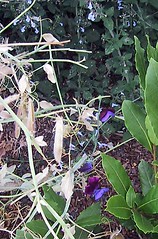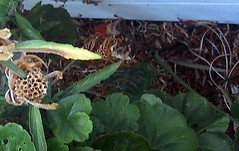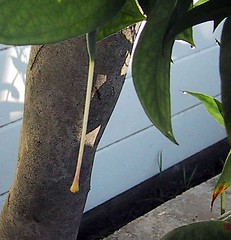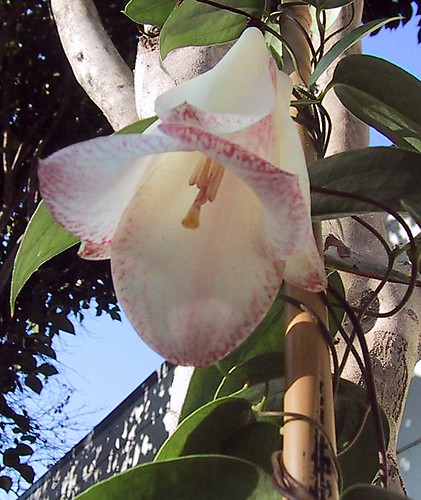September in the garden
If I have been remiss in describing what's going on in my garden, it's because I've been distracted by backbreaking labor. I'm now about halfway done with Operation Conduit '06, and then I have to excavate and build a raised bed before the rains come. Needless to say, I'm ready to be done with this bullshit.
But the garden is pretty interesting this time of year. Despite having looked dead for over a month, this heroic little sweetpea is still flowering. In the background is calamint, the binomial of which is much disputed, but we'll call it Nepetella something or other. It's been churning out a profusion of insignificant blueish flowers for months. I can't say I've cooked with it much yet.
The most exciting development in recent weeks was undoubtedly the arrival of my order from Telos rare bulbs. I've already planted a little drift of Erythronium californicum (Erythronium bulbs do not like to dry out), and a single Crinum bulbispermum. Other bulbs whose identity I'll withold for now await the raised bed.
Of course, the most beautiful flower right now is the Lapageria, and the first one finally disintegrated 3 weeks after opening. But this caused me to finally notice (you can see I'm a master of precise observation) that the style as well as the tepals are marked by the charactertistic pink mottling of this type, which is called "picotee".
The word picotee was borrowed from French in the eighteenth century specifically to describe a type of carnation, by the way. According to the OED it was not transferred to similarly marked flowers of other types until 1899. I suspect an enterprising Englishman could revise this chronology.
But the garden is pretty interesting this time of year. Despite having looked dead for over a month, this heroic little sweetpea is still flowering. In the background is calamint, the binomial of which is much disputed, but we'll call it Nepetella something or other. It's been churning out a profusion of insignificant blueish flowers for months. I can't say I've cooked with it much yet.
The most exciting development in recent weeks was undoubtedly the arrival of my order from Telos rare bulbs. I've already planted a little drift of Erythronium californicum (Erythronium bulbs do not like to dry out), and a single Crinum bulbispermum. Other bulbs whose identity I'll withold for now await the raised bed.
Of course, the most beautiful flower right now is the Lapageria, and the first one finally disintegrated 3 weeks after opening. But this caused me to finally notice (you can see I'm a master of precise observation) that the style as well as the tepals are marked by the charactertistic pink mottling of this type, which is called "picotee".
The word picotee was borrowed from French in the eighteenth century specifically to describe a type of carnation, by the way. According to the OED it was not transferred to similarly marked flowers of other types until 1899. I suspect an enterprising Englishman could revise this chronology.
The style on the second flower is more strongly marked:






0 Comments:
Post a Comment
<< Home